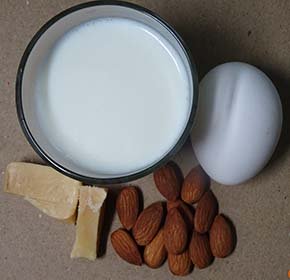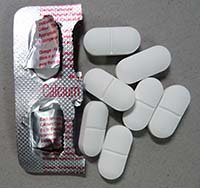Calcium Deficiency
Calcium deficiency is a condition that arises due to decreased availability of calcium ions in the serum for normal metabolic activity in humans.
A total of 1000 to 2000 grams of calcium is present in the average adult, more than 98% of it is in the skeleton.
Calcium is an essential mineral for satisfactory growth and development. It is the chief mineral in bones and teeth. Vitamin D helps in the absorption of dietary calcium in the intestinal tract.
 |
| Food sources of calcium. |
Functions of calcium in humans
Calcium is an essential anion regulating the functions of calcium channels at nerve-muscle junctions in the heart and skeletal muscles.
It, thus, plays a vital role in normal muscle contraction, nervous signal transmission, and clotting of blood (coagulation).
Mineralization of bone matrix necessitates adequate serum levels of calcium and phosphorus.
Calcium is the primary mineral in the tooth enamel which exists as hydroxyapatite (crystalline calcium phosphate).
Recommended dietary allowances of calcium-
| Category | Age Group | RDA |
| Infants | 0-6 months | 210 mg |
| 6-12 months | 270 mg | |
| Children | 1-3 years | 500 mg |
| Children | 4-8 years | 800 mg |
| Teenagers | 9-18 years | 1300 mg |
| Adults | 19-50 years | 1000 mg |
| Adults-elderly | 50 years and above | 1200 mg |
| Pregnant woman | 1000 mg | |
| Lactating Mother | 1000 mg |
What conditions cause calcium deficiency?
Causes of poor intake and low absorption (bio-availability) of calcium:
Low calcium diet, particularly those on a low-calorie diet tends to develop hypocalcemia.
Diseases of the parathyroid gland result in low parathormone secretion. Parathormone helps in the absorption of calcium in the gut and increases the calcium level in the serum.
Fat malabsorption conditions affect vitamin D absorption in the intestines.
Vitamin-D deficiency can precipitate low serum calcium levels and in severe cases may lead to hypocalcemic tetany.
Phosphate in milk, oxalates, and phytates in grains and vegetables decrease the absorption of calcium.
The calcium to Phosphorus ratio of less than two as in cow's milk reduces calcium absorption. Thus, artificially fed babies are prone to calcium deficiency.
Low Birth Weight (LBW) babies, pre-terms, infants of diabetes mothers, and those with Protein Energy Malnutrition (PEM) are more prone to have hypocalcemia. Hypocalcemia can lead to tetany (painful spasms of limbs and body parts) and convulsions.
Signs and symptoms of calcium deficiency
Bone pain/backache
Painful spasms in hands (carpal spasm)
Painful spasms in legs (pedal spasm)
Abnormal touch sensation around mouth and in the limbs
Nervousness and anxiety
Difficulty in breathing
Tetany and convulsions can occur in severe serum calcium deficiency
Prolonged calcium deficiency makes the bones weak and vulnerable to fractures.
Food sources of Calcium
Milk and milk products and seafood are the richest sources of calcium in nature. Milk calcium has the highest bioavailability, followed by seafood. Oysters, crab, fish, mutton, leafy vegetables, nuts and seeds, and millets like ragi (finger millet -E. coracana) are rich sources of calcium.
Refer the table for food sources of calcium- ≻≻| Food source | Nutrient Value | Percentage of RDA |
|---|---|---|
| Animal sources | ||
| Beef, flank, 0 fat | 25 mg | 2.5% |
| Bison, game meat, raw | 5 mg | 0.5% |
| Cheese, parmesan | 1253 mg | 125% |
| Chicken, broiler, raw | 17 mg | 1.7% |
| Egg, whole, raw | 56 mg | 5.6% |
| Lamb, lean meat | 19 mg | 1.9% |
| Milk (Indian buffelo) | 169 mg | 17% | Whey | 2094 mg | 209% |
| Seafood/Mollusk | ||
| Fish, Herring, Pacific | 83 mg | 8% |
| Spiny lobster, cooked | 7.27 mg | 66% |
| Octopus, common, raw | 53 mg | 5% |
| Oyester, farmed | 44 mg | 4.4% |
| Plant sources | ||
| Fruits | ||
| Apricot, dehydrated | 61 mg | 6% |
| Currants, zante, dried | 86 mg | 8.6% |
| Figs, raw | 35 mg | 3.5% | Vegetables |
| Arugula, raw | 160 mg | 16% |
| Beet greens, raw | 117 mg | 12% |
| Garlic, raw | 181 mg | 18% |
| Soybeans, green, raw | 197 mg | 20% | Spinach, raw | 99 mg | 10% | Nuts and seeds |
| Almonds, dry roasted | 268 mg | 27% |
| Lotus seeds, dried | 163 mg | 16% |
| Hazel nuts | 114 mg | 11% |
| Sunflower seeds, toasted | 57 mg | 6% |
Calcium Supplements
 |
| Calcium tablets |
Calcium salts such as calcium carbonate, chloride, citrate, acetate, gluconate, etc., are available in formulations from infants to adults to treat calcium deficiency after physician consultation. Calcium chloride has better bio-availability among these supplements.
Apart from prophylaxis, the supplements are often advocated to treat osteopenia/osteoporosis, menorrhagia, pre-menstrual syndromes, and post-surgical conditions.
Health risks of excessive calcium intake
Excessive intake of calcium supplements may lead to ectopic deposition of calcium salts inside the blood vessels, brain, and eye lens. In the kidneys, it may lead to the formation of urinary system stones. However, dietary calcium does not contribute to any complications.
High serum calcium levels occur in hypercalcemia conditions. It is also noted with vitamin D intoxication. The condition can lead to constipation, and interfere with the absorption of iron, zinc, and copper. (Medical disclaimer).
Read further on:
≺≺ How to Prevent Osteoporosis Naturally with Diet and Exercise.
≻≻- Zinc deficiency.
≻≻- Back to Nutrition & Wellness aticles from Calcium deficiency.
Further reading and References:
Calcium-Health Professional Fact Sheet.-Zinc Dietary Supplement Fact Sheet.